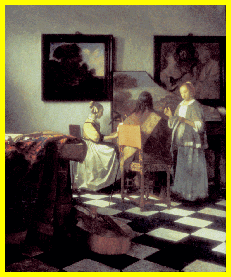|
Art TheftArt is a funny thing. Artists tend to struggle in poverty throughout their lives, then the value of their works skyrockets as soon as they kick it.Just to add insult to injury, their work is then subjected to looting and professional thievery, sometimes ending up hidden in the secret library of a wealthy collector, never to be seen again.
But for an elite few megarich assholes, there's nothing quite like the thrill of stealing a priceless original masterpiece or a valuable historical artifact and hiding it away from the unworthy eyes of the unwashed masses in a secret showroom for all time. After all, the people really don't appreciate art. They don't deserve it. Screw them. The black market in fine arts and antiquities was estimated to be worth about $5 billion a year and that was before the recent looting of Baghdad, a development which has yet to be estimated, but could realistically add as much another billion to that total for 2003. Much like wrestling, art theft breaks down into two basic categories: Amateur and professional. Amateur art theft typically involves looting sprees during wartime, while professional art theft more closely resembles a particularly elaborate episode of "Mission Impossible." The Arts of War The principle of "to the victor go the spoils" has led to many historical art plunders over the course of human history. In ancient times and all the way through the 20th century, it was presumed as international law that all members of a conquering army could help themselves to whatever they found "lying around" in museums, homes, heavily armed safeboxes, etc., etc.
The principle of "to the victor go the spoils" has led to many historical art plunders over the course of human history. In ancient times and all the way through the 20th century, it was presumed as international law that all members of a conquering army could help themselves to whatever they found "lying around" in museums, homes, heavily armed safeboxes, etc., etc. The Crusades, for instance, were responsible for shuffling items of supposed and actual value around Europe and the Middle East over the course of centuries, ranging from the contemporary equivalents of black velvet Elvis paintings to bite-sized chunks of saints' spleens. This wasn't especially remarkable to anyone at the time, it was just the way things were. The Romans took the Greeks' statues, the conquistadors looted the temples of the Mayans and Aztecs, and right up until the early 20th century, the British government looted precious artifacts from practically every civilization on earth under the pretext that they were "protecting" them. Attitudes didn't really start to change until World War II. When the Third Reich began its systematic incarceration and extermination of the Jews, they helped themselves to everything the Jews had owned. Then, when the Allies swept into Germany, they helped themselves to everything the Germans owned, which happened to include a wide assortment of things that had very recently belonged to German and European Jews. Once freed from the threat of imminent death, the Jews took exception to the Allied plunder. In previous wars, the "finders-keepers" rule hadn't been especially controversial, since the people most likely to complain had just had their asses thoroughly kicked. In this case, however, the Jewish community could make a pretty good case for the unfairness of the situation. After all, they were not the conquered subjects here. In theory, they still had a legit claim on their wealth and their cultural artifacts. It wasn't just the Jews either; the Nazis had refined the art of plunder to unprecedented levels with that ruthless efficiency you hear so much about. Adolf Hitler had a personal taste for art, and the Nazis systematically looted its conquests, including notably France and the Netherlands. This got the international community to thinking, and when the Geneva Conventions were drafted a few years later, the international community formally refuted "finders-keepers" as part of its kinder, gentler rules of combat.
In fact, one of the few industries to rival the Nazi art black market is the Nazi-art-theft-hunters market, the booming business of trying to recover lost works. Hundreds of known pieces are still missing, incluing major paintings by Renoir and Gustav Klimt, as well as probably thousands more pieces there which can be traced to World War II, but whose original owners did not survive to report the theft. The Professionals According to Interpol, the art black market is the fourth largest international criminal enterprise (after drugs, money laundering and weapons). The FBI recently pegged the size of the market to be as high as $5 billion.
According to Interpol, the art black market is the fourth largest international criminal enterprise (after drugs, money laundering and weapons). The FBI recently pegged the size of the market to be as high as $5 billion. While the gross proceeds for ventures like drugs and guns can be much, much higher, art theft tends to be a hell of a lot safer and features a more glamorous circle of associates. Thus, it attracts two major criminal types: Efficient opportunists and elite Hollywood-style superthieves. The majority of art theft tends to be "collector on collector" incidents, where private homes are robbed of either professional collections or family heirlooms. Galleries, museums and churches comprise most of the remaining victim base. During the 2003 Iraq war, professional art thieves (of the "efficient opportunist" variety) descended on Baghdad and used widespread looting to cover their activities, despite early warnings to the Bush administration from the international arts community. With soldiers distracted by bundles of $100 bills, Iraqi civilians raiding stores for cigarettes, and even U.S. journalists wantonly snatching souvenir solid-gold guns and paintings of Saddam Hussein, the professionals easily slipped under the radar, using glass cutters and archival carriers to retrieve many priceless artifacts and antiquities. Individual art thefts tend to be even more daring and spectacular. In 1911, the Mona Lisa was stolen from the Louvre.
In 1994, Edvard Munch's famous work "The Scream" was stolen from an Oslo gallery, while Norwegians were distracted by the opening of the Winter Olympics in nearby Lillehammer. Two thieves entered through a window, setting off an alarm in the process, which was ignored by the gallery's guard. They even left a note: "Thanks for the poor security." Other major heists in recent years include a major raid on Boston's Isabella Stewart Gardner Museum, estimated at hundreds of millions of dollars. Among the paintings taken was Jan Vermeer's "The Concert." The heist remains unsolved despite multimillion dollar rewards offered for the return of the art. In 2000, armed robbers stole two Renoirs and a Rembrandt from a Stockholm museum. They escaped cleanly and the art is still missing. A Picasso was swiped from the yacht of a Saudi businessman in France in 1999 and is still being sought. (What kind of person keeps a Picasso on a yacht?) A reward in excess of $500,000 is offered for its return. A Forever Problem The theft of art and antiquities is one of those problems that will probably persist until civilization collapses into dust, since there will always be wealthy people who want to own things simply "because."
The theft of art and antiquities is one of those problems that will probably persist until civilization collapses into dust, since there will always be wealthy people who want to own things simply "because."Museums aren't exactly flush with funds, and while the biggest and best-funded have spent millions on high-tech security in the decades since the Mona Lisa was swiped, the sophistication of thieves has easily kept pace. And the looting of Baghdad shows there are still plenty of greedy opportunists willing and able to take advantage of chaos to grab an armful of priceless history (which generally not as heavy as a TV set). International law enforcement has stepped up efforts to find and arrest art thieves with a certain degree of success. There are two basic types of theft theft with intent to sell on the open market, and theft commissioned by wealthy private individuals who want to keep them in their secret vaults.
Thefts in the latter category commissioned on behalf of individuals are much harder to solve. Since the motive generally boils down to "insane hoarding," the art doesn't tend to emerge on the open market, or at least not until after the death of the collector. The only people who see the stolen goods are the close friends and family of the insane wealthy people, who for some reason often tend to be insane wealthy people themselves. So the Rembrandt you've got hidden behind the secret revolving door in the library is likely to stay there, unless you're really an idiot. However, it's still not a nice thing to hoard priceless and unique works of art that might help increase the amount of beauty and truth in the world. So, knock it off, would you? Thanks. |
 The concept of fine arts theft is one of the most pointlessly selfish activities known to civilization. You can commission a flawless reproduction of just about any artwork for just a few thousand dollars in most cases, perhaps tens of thousands for something really special.
The concept of fine arts theft is one of the most pointlessly selfish activities known to civilization. You can commission a flawless reproduction of just about any artwork for just a few thousand dollars in most cases, perhaps tens of thousands for something really special.  This came too late to help the victims of Nazi plunder, of course. The masterpieces, precious metals and jewels and religious artifacts had been spread far and wide, some looted by soldiers, some stolen by fleeing Nazis, some lost in undiscovered safeboxes, and a whole lot of it soaked up by the international black market for fine arts, one of the world's most efficient and tight-knit industries.
This came too late to help the victims of Nazi plunder, of course. The masterpieces, precious metals and jewels and religious artifacts had been spread far and wide, some looted by soldiers, some stolen by fleeing Nazis, some lost in undiscovered safeboxes, and a whole lot of it soaked up by the international black market for fine arts, one of the world's most efficient and tight-knit industries. The perpetrator hid in the museum on a Sunday afternoon (it was closed on Monday). He took the picture and frame down from the wall, walked to a stairwell, removed the painting from the frame and simply walked out the front door. It took two days for anyone to notice it was gone. Pablo Picasso was among those arrested for interrogation (he had helped steal two busts from the Louvre years earlier, but escaped prosecution). The culprit turned out to be an Italian tradesman who
The perpetrator hid in the museum on a Sunday afternoon (it was closed on Monday). He took the picture and frame down from the wall, walked to a stairwell, removed the painting from the frame and simply walked out the front door. It took two days for anyone to notice it was gone. Pablo Picasso was among those arrested for interrogation (he had helped steal two busts from the Louvre years earlier, but escaped prosecution). The culprit turned out to be an Italian tradesman who  Art stolen by members of the former group tends to be recovered within a decade or so of its disappearance. It's just a tricky thing to move a multimillion dollar masterpiece without attracting attention. There are only so many places you can go for the big bucks, and the odds are fairly good that someone with half a scruple (and perhaps a desire for a risk-free reward from Interpol) will notice that you've got a long-lost DaVinci posted on eBay and make a call.
Art stolen by members of the former group tends to be recovered within a decade or so of its disappearance. It's just a tricky thing to move a multimillion dollar masterpiece without attracting attention. There are only so many places you can go for the big bucks, and the odds are fairly good that someone with half a scruple (and perhaps a desire for a risk-free reward from Interpol) will notice that you've got a long-lost DaVinci posted on eBay and make a call.